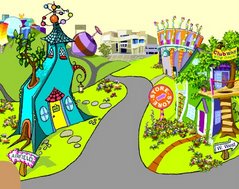Recent Whyville Presentations 2008
This spring and summer we've presented many times about our research on Whyville. Here are a few titles - with papers being written this fall.
AERA: March 2008
Fields, D. F., Giang, M. & Kafai, Y. B. (2008, March). Girl gamers in virtual worlds: Portraits of participation and positionings in a tween gaming club. Paper presented at the annual meeting of the American Educational Research Association, New York, NY.
Cook, M. S., Fields, D. F. & Kafai, Y. B. (2008, March). “Should I get this skin color for my head?” Conversations about race in a tween gaming club. Paper presented at the annual meeting of the American Educational Research Association, New York, NY.
Cultures of Virtual Worlds: April 2008
Fields, D. F. & Kafai, Y. B. (2008, April). Race, gender, and trading face parts: A case study of identity construction in a tween virtual world. Paper presented at the Cultures of Virtual Worlds Conference, Irvine, CA.
ICLS: July 2008 (see http://www.isls.org/icls2008/ for pdfs of papers)
Fields, D. F. & Kafai, Y. B. (2008). Knowing and throwing mudballs, hearts, pies, and flowers: A connective ethnography of gaming practices. In V. Jonker , A. Lazonder, & C. Hoadley (Eds.) Proceedings of the Eighth International Conference of the Learning Sciences, Utrecht, Netherlands: University of Utrecht.
Kafai, Y. B. & Wong. J. (2008). Real Arguments about a Virtual Epidemic: Conversations and Contestations in a Tween Gaming Club Paper
Games + Learning + Society: July 2008
Fields, D. F. & Kafai, Y. B. (2008, July). How does someone become a Whyvillian? Issues of race, gender, and trading face parts in a case study of tween play in a virtual world. Paper presented at the annual conference of Games + Learning + Society 4.0, Madison, WI.
ISCAR: September 2008
Fields, D. F. & Kafai, Y .B. (2008, September). Projectile throwing as a tool to mediate relationships: A connective ethnography of a gaming practice in a tween virtual world. Paper presented at the biannual conference of the International Society of Cultural and Activity Research (ISCAR), San Diego, CA.


No comments:
Post a Comment